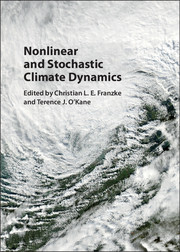Book contents
- Frontmatter
- Contents
- List of Figures
- List of Contributors
- Preface
- 1 Challenges for Ice Age Dynamics: A Dynamical Systems Perspective
- 2 Tipping Points in the Climate System
- 3 Atmospheric Teleconnection Patterns
- 4 Atmospheric Regimes: The Link between Weather and the Large-Scale Circulation
- 5 Low-Frequency Regime Transitions and Predictability of Regimes in a Barotropic Model
- 6 Complex Network Techniques for Climatological Data Analysis
- 7 On Inference and Validation of Causality Relations in Climate Teleconnections
- 8 Stochastic Climate Theory
- 9 Stochastic Subgrid Modelling for Geophysical and Three-Dimensional Turbulence
- 10 Model Error in Data Assimilation
- 11 Long-Term Memory in Climate: Detection, Extreme Events, and Significance of Trends
- 12 Fractional Stochastic Models for Heavy Tailed, and Long-Range Dependent, Fluctuations in Physical Systems
- 13 Modelling Spatial Extremes Using Max-Stable Processes
- 14 Extreme Value Analysis in Dynamical Systems: Two Case Studies
- Index
1 - Challenges for Ice Age Dynamics: A Dynamical Systems Perspective
Published online by Cambridge University Press: 26 January 2017
- Frontmatter
- Contents
- List of Figures
- List of Contributors
- Preface
- 1 Challenges for Ice Age Dynamics: A Dynamical Systems Perspective
- 2 Tipping Points in the Climate System
- 3 Atmospheric Teleconnection Patterns
- 4 Atmospheric Regimes: The Link between Weather and the Large-Scale Circulation
- 5 Low-Frequency Regime Transitions and Predictability of Regimes in a Barotropic Model
- 6 Complex Network Techniques for Climatological Data Analysis
- 7 On Inference and Validation of Causality Relations in Climate Teleconnections
- 8 Stochastic Climate Theory
- 9 Stochastic Subgrid Modelling for Geophysical and Three-Dimensional Turbulence
- 10 Model Error in Data Assimilation
- 11 Long-Term Memory in Climate: Detection, Extreme Events, and Significance of Trends
- 12 Fractional Stochastic Models for Heavy Tailed, and Long-Range Dependent, Fluctuations in Physical Systems
- 13 Modelling Spatial Extremes Using Max-Stable Processes
- 14 Extreme Value Analysis in Dynamical Systems: Two Case Studies
- Index
Summary
Abstract
This chapter is dedicated to the slow dynamics of the climate system, at time scales of 1000 to 1 million years. We focus specifically on the phenomenon of ice ages that has characterised the slow evolution of climate over the Quaternary. Ice ages are a form of variability featuring interactions between different large-scale components and processes in the climate system, including ice sheet, deep-ocean and carbon cycle dynamics. This variability is also at least partly controlled by changes in the seasonal and latitudinal incoming solar radiation associated with the combined effects of changes in Earth's orbit shape, precession of equinoxes, and changes in obliquity. A number of possible mechanisms are reviewed in this chapter. We stress that the nature of the interactions between these slow dynamics and faster modes of variability, such as millennium and centennial modes of variability, are still poorly understood. For example, whether the time sequence of ice ages is robustly determined or not by the astronomical forcing is a matter of debate. These questions need to be addressed with a range of models. We propose to use stochastic parameterisations in the lower-resolution models (focusing on climate time scales) to account for weather and macro-weather dynamics simulated with higher-resolution models. We discuss challenges – including statistical challenges – and possible methods associated with this programme.
If […] we look in the 21st century and make an optimistic forecast on the type of computer which will be available […] We may construct a super-model […] When we integrate the equations, if they are correct, we shall necessarily obtain changes in climate, including the great ice ages.
— Edward Lorenz, 1970The Ice Age Phenomenon
Short Summary of Observational Evidence
Glacial cycles, or ice ages, are a form of climate variability that can be characterised as the succession of interglacial (similar to today) and glacial conditions over time scales of several tens of thousands of years. At the Last Glacial Maximum – 21,000 years ago, henceforth noted 21 ka BP – the sea-level was 120 m lower than today.
- Type
- Chapter
- Information
- Nonlinear and Stochastic Climate Dynamics , pp. 1 - 32Publisher: Cambridge University PressPrint publication year: 2017



